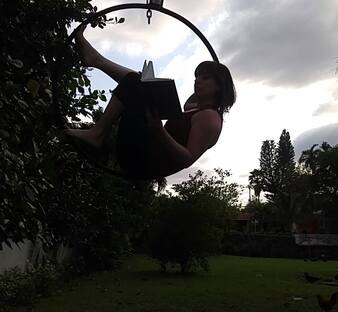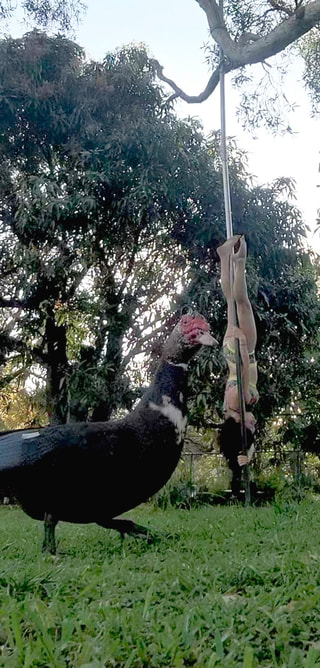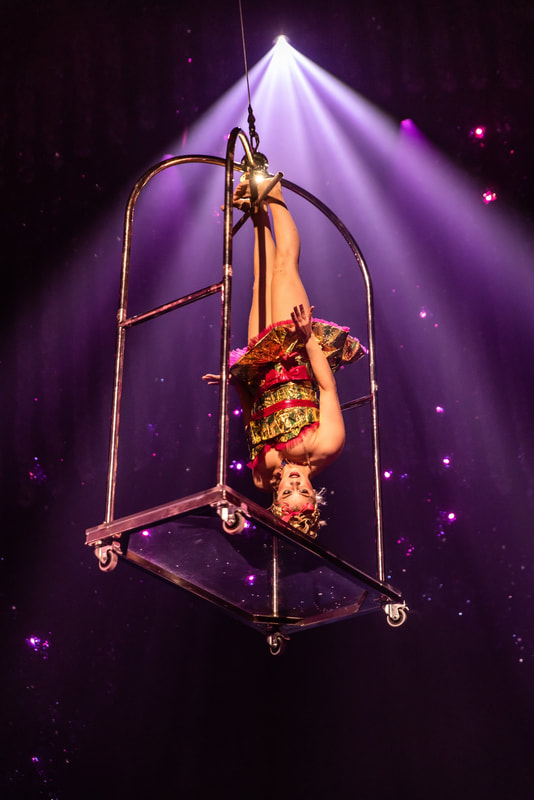|
Many people now engage in pole dancing and aerial activities such as aerial silks. Increasingly adults have taken up these practices as leisure and fitness activities. The social theorist Bruno Latour tells us to follow objects and to look at those who attempt to speak for them. My research on pole and aerial includes examining how a pole and other aerial apparatuses have become more than simple pieces of metal and fabric. My research on this topic is ongoing.
|
|
|
Pole dancing comes out of strip clubs. It currently straddles the adult entertainment, art, fitness, and sporting industries. Poling is an activity that is inclusive of people of diverse backgrounds, ages, races/ethnicities, and physicalities. Instructors have told me how they use the pole to encourage people to explore and appreciate their bodies' movements. Deb Roach in a 2021 chat on Instagram hosted by Smink provided food for thought on how to approach teaching polers with disabilities:
"[Adaptations for pole moves] is just us [people with disabilities] taking what mainstream pole is doing and adapting the moves and that is one way to go about it. But [I created a system and] what my system was about was translation. So taking pole movement and allowing- giving the person with the disability that’s in front of you the tools and the resources to share with you, to explore the movement, and to translate it into something that is genuine and authentic to them." |
|
"Our whole shabang is very LGBTQ friendly so there is the new gaze. It’s not male. It’s not female. It’s 'You go girl.'"
--Interview with someone who started a pop-up strip club in the southern U.S. |
|
photo by Jp Valery
|
Strippers have long been leveraging their pole skills in adult contexts as part of their jobs. "When I perform, I feel like I'm giving off these musical notes, that are just like wrapping people, and just drawing them to me. And I feed off that moment. And that's what makes it so free, like people are freeing themselves with me. I love that." --Interview with Mona Marie of Poletic Justice Poling as a symbol of athleticism and sensuality was shaped by this work; the first pole fitness classes taught in recent decades were taught by strippers. Therefore, strippers argue that those who borrow from them while stigmatizing them are engaging in a form of cultural appropriation. |
|
Strippers talked with me about the current industry and where negative working conditions exist for strippers/sex workers. While some commentators argue strippers exhibit a false consciousness, actions by sex workers challenge this narrative, such as: stripper strikes in the United States against racism and unfair labor practices, as well as petitions and legal challenges against exploitative labor practices in the U.S., Canada, and Europe. The latter reference unsafe aerial equipment, and quotas/fees/rules that treat strippers like workers (versus self-employed) without granting them those benefits and protections. For more information, check out sex worker organizations and advocacy groups.
Click here for an article I published with Dr. Hipke on pole dancing in strip clubs. |
"I broke the pole right off the stage and sliced my hip open. I had to get ten stitches. ... [I started a petition for better equipment and working conditions.] I'm only asking for a few things, like some safety and some cleanliness, and let us keep all our dance money."
--Interview with Sachi ONYX Keller, who is one of the hosts of Yes, a Stripper podcast |
A central factor in the expansion of pole as a fitness activity and sport that is often neglected is the pole itself. Companies have designed poles that are safe, portable, can easily shift from static to spinning, and can be attached to slanted ceilings. Pole Danzer and X-Pole were two early companies in the field.
|
"We manufactured the pole. . . . [But at the time there was not a market outside of strip clubs.] So then I realized that the key way to expand the market was to expand the schools [teaching pole]. . . . We had a lot of feminist organizations kicking off with this: 'You're denigrating women.' But then when you get a person doing it, they just love it, and it becomes part of their life. . . . That's why we promoted fitness, fitness, fitness. . . . In order to expand the market [we had to change people's mentality about pole dance and what it means.]"
-- Interview with Clive Coote of X-Pole |
"I built a pole [for my wife and my friends] would see it and then they would want one. . . . [We put up a website] and they just started selling from the beginning [since 2000]. . . . In the old days there was nothing. Nobody made a spinning pole. I’m not saying that I invented the spinning pole but I was probably the first person on the market with a spinning pole. So then all the clubs, the women would go, I want the pole to spin. . . . It’s so much easier for the women just to spin with the pole spinning than to actually force their body around. [Our poles are in locations from strip clubs, to pole studios, to restaurants, to planes and limousines.]"
-- Interview with Robert Trent of Pole Danzer |
Companies and individuals are continuing to develop new and creative aerial apparatuses.
|
Masha Terentieva is an award-winner circus performer artist, director, and concept designer. One apparatus she designed is the aerial hotel cart. She got the idea from playing around on a normal cart in a hotel. It allows for the performance of static movements and shapes, as well as aerial ones when the hotel cart flies in the air. "With the hotel cart there's a loaded metaphor, the symbolism of it. It's an everyday object that is familiar to everybody. My character [when I perform with the hotel cart] also starts out as a bellhop. So people first think, oh, it's just a prop. And then when it starts to become this aerial apparatus, it's this metaphor of a dream, of a dream to fly away, to break out of the routine of the ordinary, to try to live out the craziest, extraordinary potential that a person might have. But there's also a bit of tragedy in it [when the worker goes back to their everyday life]."
|
photo taken from http://terentiev.com/masha/media/
|
ThePole by AGM Design, for instance, offers a unique aerial hexagon shape amongst other pole and aerial equipment offerings.

Pole has become shaped into a competitive sport in recent years. For instance, at least 30 countries have federations endorsed by the International Pole Sports Federation (IPSF), and hundreds of pole studios exist in the United States alone. Poling has garnered public attention in recent years because the IPSF was granted Observer Status by the Global Association of International Sports Federation (GAISF), leading to speculation over whether pole sports will one day be included within the Olympics.




